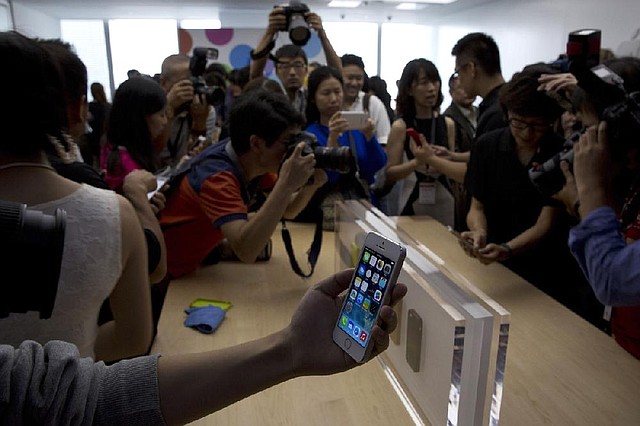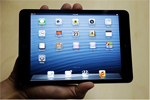New iPhone strategy trips Apple
Company’s shares dip 5.4% after two devices fail to impress
Thursday, September 12, 2013
Apple Inc. shares fell the most in almost five months Wednesday after the company unveiled two iPhones that were criticized by analysts as lacking enough new features or a sufficiently low price to attract a broad range of new customers.
In a break with the past, when the company introduced one iPhone a year, Apple on Tuesday unveiled two models. The iPhone 5C will cost $99 to $199 with a wireless contract and comes in five different colors. A high-end iPhone 5S with fingerprint-security features, a speedier processor and better camera will cost $199 to $399 and be available in three colors.
Apple’s shares fell $26.93, or 5.4 percent, to close Wednesday at $476.71.
The devices highlight a shift in the $280 billion smartphone industry, as the novelty of Internet-connected handsets wears off and the gadgets share many of the same basic features. Facing increasing competition from rivals such as Samsung Electronics Co. that offer mobile phones with different designs and prices, Apple Chief Executive Officer Tim Cook is following suit and expanding his company’s lineup to court more style conscious customers and users in developing markets.
“We’ve gotten through the first phase of the industry,” said Benedict Evans, a mobile phone industry analyst at Enders Analysis. “The original vision has been built out. We’re now in a market where Apple is fighting on more equal terms.”
Apple’s strategy shift includes what is essentially a repackaging of last year’s iPhone 5 in a new polycarbonate casing that comes in blue, pink, green, yellow and white to become the iPhone 5C. The company isn’t pricing the 5C as cheaply as competitors’ handsets, with the phone costing $549 and higher without a two-year contract, according to Apple’s U.S. website, showing it’s unwilling to trade its industry-leading profit margins for increased market share.
Investors had expected a lower price for the iPhone 5C to appeal to more customers in emerging markets such as China, according to Brian Blair, an analyst at Wedge Partners Corp., who attended the Apple event.
“Nobody expected it to be this high,” Blair said. “They are clearly saying, ‘We aren’t willing to go downstream.’”
Analysts at UBS AG, Bank of America Corp. and Credit Suisse Group AG downgraded Apple’s stock, saying the high price will limit sales in emerging markets.
Even so, Apple is increasing its pool of potential customers. Apple said it is adding Japan’s largest carrier, NTT DoCoMo Inc., and that it will have devices immediately available in China for the first time. The company is near a deal with China Mobile Ltd., the world’s largest carrier, people familiar with the plans have said.
The shift in iPhone strategy is a turnabout for Apple, which has long been the pacesetter in the smartphone market. When Apple co-founder Steve Jobs unveiled the iPhone in January 2007, he upended a market dominated by Nokia Oyj’s feature phones and BlackBerry Ltd.’s keyboard handsets.
As the iPhone gained in popularity to become a preeminent device for consumers, catapulting Apple’s stock to make it the world’s most valuable company, Google Inc. pushed its Android software with Samsung, HTC Corp. and other handset manufacturers that soon produced touchscreen devices.
Each iPhone unveiling is critical for Apple, because the smartphone accounts for about half of its revenue. Tuesday’s event was the company’s first major product debut since the iPad mini was introduced last year. Absent new gadgets, Apple’s growth has stagnated, with earnings falling last quarter.
Apple is responding with the new iPhones, which debuted in front of a crowd that included Apple board member and former U.S. Vice President Al Gore, Yahoo Inc. CEO Marissa Mayer and Twitter Inc. co-founder Jack Dorsey. Musician Elvis Costello also played toward the end of the event.
The new iPhones will hit stores on Sept. 20. The iPhone 5S will come in white, black and gold and has a 64-bit chip that the company said will make it work twice as fast as the iPhone 5. It will also have Touch ID fingerprint-sensor technology that is located on the phone’s Home button, which people can use to unlock their device and confirm purchases from iTunes and Apple’s app store. Without a contract, the 5S costs $649 to $849, according to Apple’s online store.
The high off-contract prices indicate Apple is still betting customers will pay more for the iPhone, said Sarah Rotman Epps, an analyst at Forrester Research.
“They aren’t trying to compete for the bottom of the market,” she said, adding that Apple is keeping its strategy of appealing to the “well-off masses.”
Apple also revamped its mobile software with the introduction of iOS 7, which will be available for free starting Wednesday. The overhaul includes new sounds, picture sharing tools and an iTunes radio feature.
At the event, the company said 700 million iOS devices would be sold by next month. Apple added that its Siri digital assistant is “massively improved” and now draws information from Twitter and Wikipedia, among other sources.
More new Apple products are anticipated this year in the run-up to the Christmas shopping season. The company is planning to introduce new iPads later this year, people familiar with the plans have said.
Business, Pages 23 on 09/12/2013

